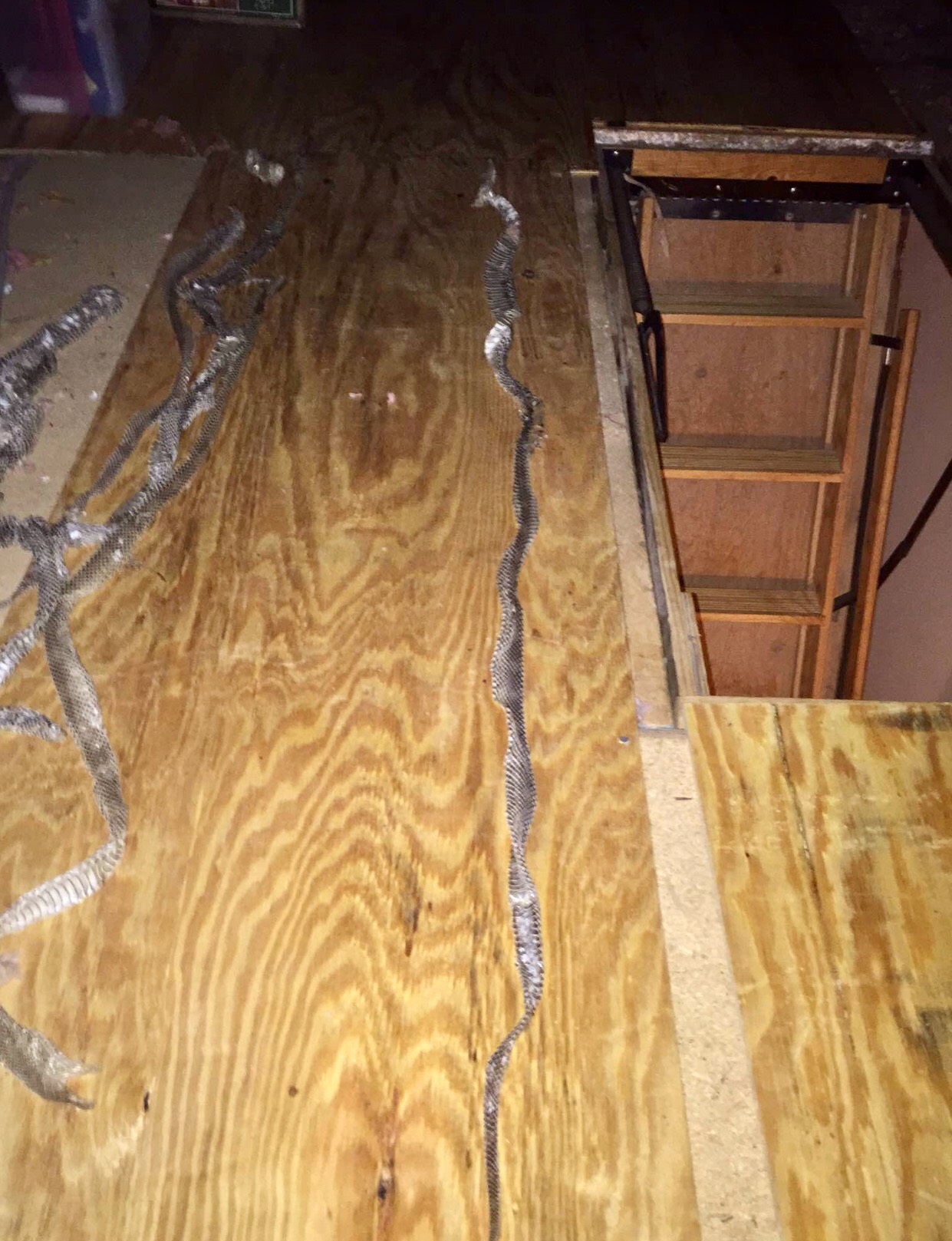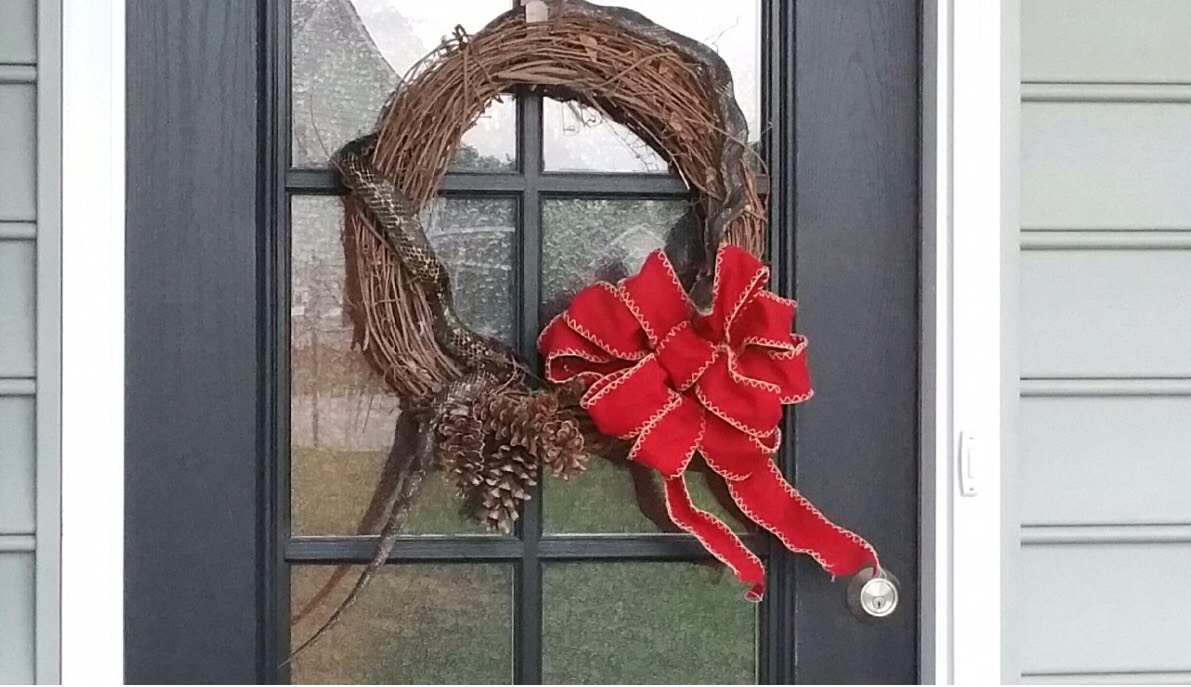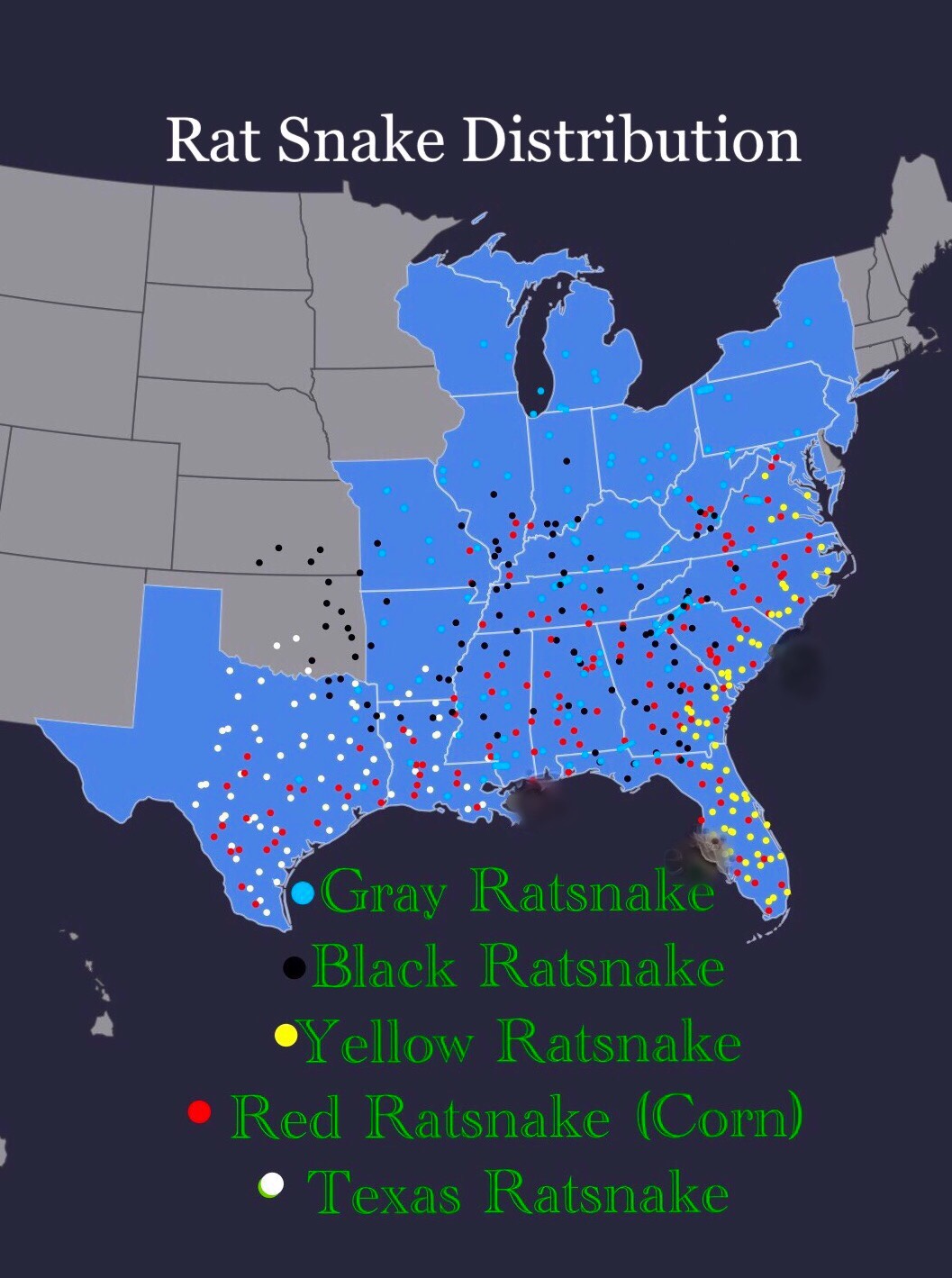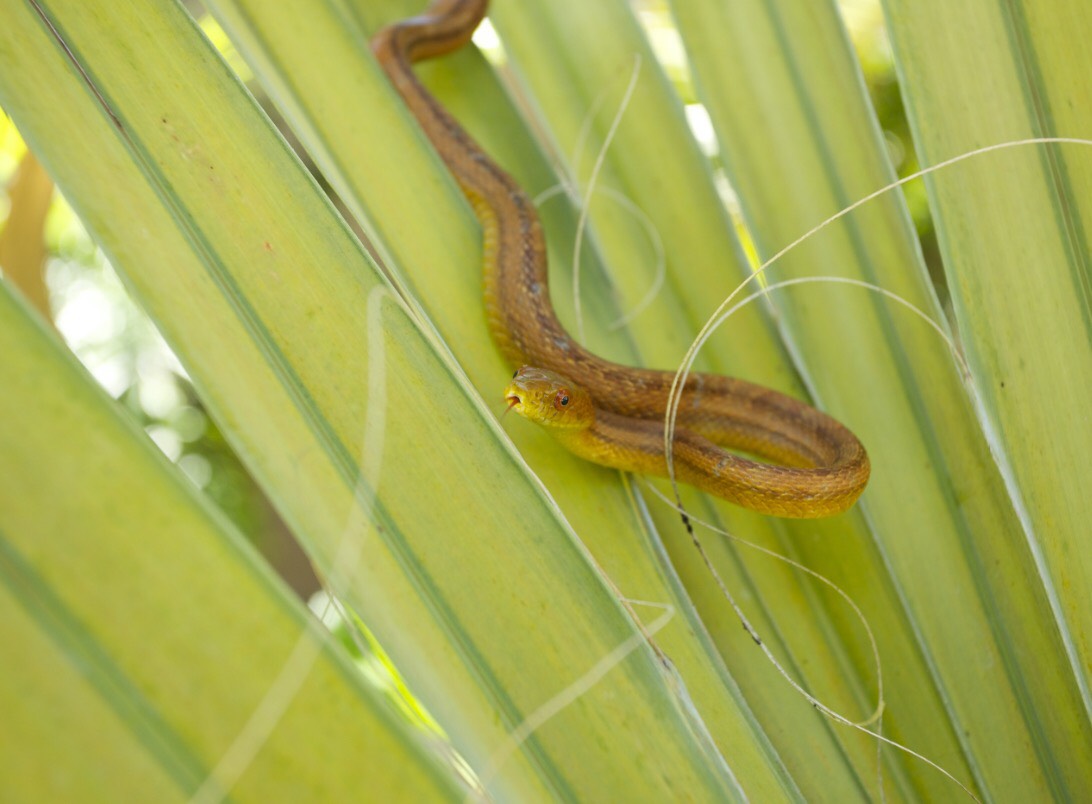Gray Rat Snake
 The gray ratsnake, often referred to as the “chicken snake” or the “rat snake”, is the most common snake found to enter homes in Tennessee, Kentucky, South Carolina, Florida, North Carolina, Ohio, Virginia, Georgia, Alabama, Mississippi, and Arkansas. They are excellent at climbing, and can even use mortar lines in between bricks to scale up the side of a home, often reaching sizes of 40″-70″ in length. They are extremely common in the Eastern and Central United States. Attics are a favorite place for gray ratsnakes, where they love the warmth being cold blooded, and will often find a rodent or bird to prey on. Gray rat snakes can also utilize trees that overlap your roofline to gain access on top of your home. Common calls we receive involving gray ratsnakes include:
The gray ratsnake, often referred to as the “chicken snake” or the “rat snake”, is the most common snake found to enter homes in Tennessee, Kentucky, South Carolina, Florida, North Carolina, Ohio, Virginia, Georgia, Alabama, Mississippi, and Arkansas. They are excellent at climbing, and can even use mortar lines in between bricks to scale up the side of a home, often reaching sizes of 40″-70″ in length. They are extremely common in the Eastern and Central United States. Attics are a favorite place for gray ratsnakes, where they love the warmth being cold blooded, and will often find a rodent or bird to prey on. Gray rat snakes can also utilize trees that overlap your roofline to gain access on top of your home. Common calls we receive involving gray ratsnakes include:
- Snakes in the toilet
- Snakes in the attic
- Snakes in the crawlspace
- Snake skin found in attic
- Snake in garage
- Large snake hanging from ceiling
- Hear what sounds like a snake behind the drywall
- Snake in the yard
- Snake behind refrigerator
- Snake in hot water heater
- Snake under AC unit
- Snake on window sill
- Snake in car or vehicle
- Snake on roof
When Encountered
 As a defense mechanism, the grey rat snake will coil itself up in the classic “S” position and puff its body up. Gray ratsnakes will rattle their tail, or vibrate it fast enough to produce a rattle sound, even though it is not a rattlesnake. They can grow very large, as we have found them up to 9′ ft in length.
As a defense mechanism, the grey rat snake will coil itself up in the classic “S” position and puff its body up. Gray ratsnakes will rattle their tail, or vibrate it fast enough to produce a rattle sound, even though it is not a rattlesnake. They can grow very large, as we have found them up to 9′ ft in length.
They are found throughout TN, KY, OH, IN, IL, SC, NC, VA, GA, and FL. Gray ratsnakes will strike, if too close or it is agitated, so it is best to keep your distance. Gray ratsnakes will often feed on rodents, birds, and other small mammals and can live up to 15 years in the wild.
If handled or picked up, the gray rat snake can secrete a foul smelling liquid out of its cloaca to thwart a potential threat.
Gray Ratsnake Identification
 Gray ratsnakes are opportunistic, and will enter unguarded vents, gaps, and openings outside your home. They will leave evidence if they have been in or around your structure in a variety of ways. Droppings will often be a 1″ – 1 1/2″ , brown in color, and have a white-tip on the end. Gray ratsnake skins can commonly be found in structures, and can vary in length from a 2 feet to 8 feet in length. They do shed once a year, so if you find multiple skins, the problem has likely occured yearly and you have had more than one snake utilizing your structure. With any snake found in a home, there will also be the food source the snake is after, which can be mice, rats, birds, lizards, bats, and even squirrels. Adult gray ratsnakes will often be darker green, black, or brown in color with a gold to tan to yellow pattern on the back, with a white underside.
Gray ratsnakes are opportunistic, and will enter unguarded vents, gaps, and openings outside your home. They will leave evidence if they have been in or around your structure in a variety of ways. Droppings will often be a 1″ – 1 1/2″ , brown in color, and have a white-tip on the end. Gray ratsnake skins can commonly be found in structures, and can vary in length from a 2 feet to 8 feet in length. They do shed once a year, so if you find multiple skins, the problem has likely occured yearly and you have had more than one snake utilizing your structure. With any snake found in a home, there will also be the food source the snake is after, which can be mice, rats, birds, lizards, bats, and even squirrels. Adult gray ratsnakes will often be darker green, black, or brown in color with a gold to tan to yellow pattern on the back, with a white underside.
Where Can Gray Ratsnakes Be Found
 Gray Ratsnakes can be found throughout the Central and Eastern United States, and are quite common around structures including found in homes, tree tops, attics, crawl spaces, sheds, barns, and fields. Around structures, gray ratsnakes hunt by scent, and will be attracted to bird nests around a home, or even a opening mice are using looking for a easy meal. With snakes being cold-blooded, any kind of heat source around a structure will be a good spot for a snake to be. Gray ratsnakes can commonly be found in:
Gray Ratsnakes can be found throughout the Central and Eastern United States, and are quite common around structures including found in homes, tree tops, attics, crawl spaces, sheds, barns, and fields. Around structures, gray ratsnakes hunt by scent, and will be attracted to bird nests around a home, or even a opening mice are using looking for a easy meal. With snakes being cold-blooded, any kind of heat source around a structure will be a good spot for a snake to be. Gray ratsnakes can commonly be found in:
What Do They Eat
 Gray Ratsnakes are carnivorous, meaning they can prey on birds, small animals, rodents, eggs, lizards, and frogs. They have a voracious appetite.
Gray Ratsnakes are carnivorous, meaning they can prey on birds, small animals, rodents, eggs, lizards, and frogs. They have a voracious appetite.
They can commonly be found raiding chicken coops of eggs, and found slithering in a open garage door. During summer time, gray ratsnakes can be nocturnal, moving at night time.
Gray ratsnakes can grow to large lengths, often reaching lengths up to 8ft, which is why cleaning out a nest of baby birds for the snake, is hard to pass up.
Breeding and Reproduction
 Breeding starts in March for gray ratsnakes and will last through June. It takes 50-70 days for 5-27 eggs to hatch, before the hatchlings start appearing August. Hatchlings will be 12″-18″ in length, and will be completely independent from mother. Juvenile gray ratsnakes will have a more gray-brown blotched appearance, rather than the darker adults. During mating season, if you encounter a gray ratsnake around a structure, the chances are you will have another one or two close by. More than one adult gray rat snakes can be commonly found in structures during mating season. Snakes also shed once a year, so if you find multiple skins in your attic or home, then chances are there is more than one snake.
Breeding starts in March for gray ratsnakes and will last through June. It takes 50-70 days for 5-27 eggs to hatch, before the hatchlings start appearing August. Hatchlings will be 12″-18″ in length, and will be completely independent from mother. Juvenile gray ratsnakes will have a more gray-brown blotched appearance, rather than the darker adults. During mating season, if you encounter a gray ratsnake around a structure, the chances are you will have another one or two close by. More than one adult gray rat snakes can be commonly found in structures during mating season. Snakes also shed once a year, so if you find multiple skins in your attic or home, then chances are there is more than one snake.
Distribution

 Gray ratsnakes can be commonly found from Kentucky down to Florida, and will be extremely common in the central states of Tennessee, Ohio, Illinois, Virginia, Georgia, South Carolina, North Carolina, and Indiana. The gray ratsnake will be the most common snake found around structures in most states.
Gray ratsnakes can be commonly found from Kentucky down to Florida, and will be extremely common in the central states of Tennessee, Ohio, Illinois, Virginia, Georgia, South Carolina, North Carolina, and Indiana. The gray ratsnake will be the most common snake found around structures in most states.
 Red ratsnakes or “cornsnakes”, will be reddish – orangish, and will have a little yellow in the blotched pattern. They can commonly be found in Florida and even Southern Middle Tennessee. They are well known for being Florida’s best climbing snake.
Red ratsnakes or “cornsnakes”, will be reddish – orangish, and will have a little yellow in the blotched pattern. They can commonly be found in Florida and even Southern Middle Tennessee. They are well known for being Florida’s best climbing snake.
 Black ratsnakes are the most widely distributed common rat snake, being found from Massachusetts through Southern Georgia. They can be a variation of dark shades to all black in color. Common names for the black ratsnake include “black chicken snake”, “chicken snake”, and “cow snake”.
Black ratsnakes are the most widely distributed common rat snake, being found from Massachusetts through Southern Georgia. They can be a variation of dark shades to all black in color. Common names for the black ratsnake include “black chicken snake”, “chicken snake”, and “cow snake”.
 The yellow ratsnake is a yellow variant colored snake that will be dingy yellow with four dark stripes running along the top of the body. They are common along the Eastern Coastal areas including Florida, South Carolina, North Carolina, Virginia, and Georgia.
The yellow ratsnake is a yellow variant colored snake that will be dingy yellow with four dark stripes running along the top of the body. They are common along the Eastern Coastal areas including Florida, South Carolina, North Carolina, Virginia, and Georgia.
 The everglades ratsnake, is a burnt orange colored rat snake specific to Florida’s everglades in the Southern part of the state. The have a striking color, which will usually be yellow on the underneath side of the snake.
The everglades ratsnake, is a burnt orange colored rat snake specific to Florida’s everglades in the Southern part of the state. The have a striking color, which will usually be yellow on the underneath side of the snake.
 Texas Ratsnakes have a voracious appetite, and will be very similar to the gray ratsnake in color, pattern, diet, and size. Texas ratsnakes occur in Texas, Louisiana, and Oklahoma.
Texas Ratsnakes have a voracious appetite, and will be very similar to the gray ratsnake in color, pattern, diet, and size. Texas ratsnakes occur in Texas, Louisiana, and Oklahoma.
